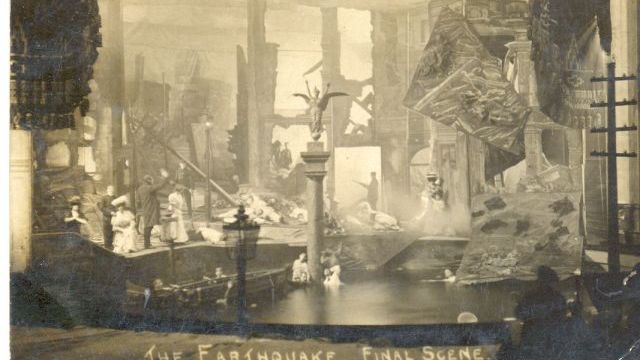Making a Scene in the 1800s
Leann Richards discovered that making a living in the craft side of the performing arts has long been hard going.
The 19th century was a time of change for the art of scenic design. In the last years of the century the introduction of electricity and development of three dimensional stage design turned the artist designer into a multi tasking tradesman.
One of the greatest influences on scenic design in the mid 19th century was the imported designers from Britain. Managers brought the best work of English scenic designers here. Many of the designers who came, including WB Spong and George Gordon, stayed and influenced the next generation of Australian designers.
Scenic design was the domain of talented artists, and the act drops in Sydney’s theatres were spectacular scenes which were major works of art. The Victoria Theatre in Pitt Street had a back drop of Sydney Harbour which was painted by WJ Wilson, and for The Gaiety the same designer painted a Venetian landscape. The Criterion had a back drop which represented the founding of Australia painted by Alfred Clint. This was later replaced by a classical scene, painted by WB Spong, which featured figures painted by famous Australian artist Tom Roberts.
In the mid 19th Century, scene designers were artisans and Roberts was one of many who contributed to the beautiful designs which were repeatedly viewed by an audience during the performance. Landscape painter Alf Tischbauer was another artist who contributed greatly to early Australian scenic design.
For the Australian who wished to become a scenic designer the road was long. It involved a lengthy apprenticeship on low wages and little support once the apprenticeship was over. In 1881, 16 year old Jack Ricketts was apprenticed to Maximillan Meyer for four years. In return for 30 guineas Meyer promised to teach young Jack calligraphy, illumination, writing and drawing. Jack was essentially an indentured labourer for four years.
By the time he left his apprenticeship, the trade was changing drastically. No longer were scenic designers expected merely to paint. The designer had to incorporate lighting effects, create three dimensional props and realistic effects to entertain a more demanding and sophisticated audience.
After the four years of his apprenticeship was over, Jack was left on his own to find work. Most scenic designers were independent contractors who had to negotiate their own agreements with various managers and producers. Jack was fortunate to have friends in the industry and often got work through these contacts.
But it was a life of missed opportunities, scrounging for cash, negotiating with managers, and having contracts dishonoured. At times things were so dire that Jack had to borrow money from friends like Tischbauer, who had taken to teaching due to the uncertain nature of the scenic design trade. Jack in turn lent money to other designers who had fallen on hard times. The tight camaraderie between the designers was maintained by regular correspondence about unreliable managers and upcoming opportunities.
Alf Tischbauer, an old school designer and landscape painter, was working as a teacher by the 1890s. He was desperate to escape his situation return to his profession, but his style and technique were outdated. In a letter to Jack Ricketts he said
If you ever hear of something good or read about it in the papers let me know. I always make it a duty to read religiously and daily that page in which our fate may be decided.
The combination of theatrical grudge and outdated technique led to Tischbauer leaving Australia to find work overseas.
As the century drew to a close, the scenic designer became a jack-of-all-trades. In 1896 Jack was offered a job taking down and touching up cloths, supervising the loading of luggage onto trains, and acting a bit part as a bushranger in Robbery Under Arms. For this multi-tasking he was offered the grand total of 3 pounds, 10 shillings a week.
Despite the formation of the stage hands union in 1890, the combination of economic depression and consequent desperation lead to scenic artists suffering poverty, low wages and poor employment conditions. In an 1892 letter, Jack writes of using his own money to finish a job.
The problems of the contractor and artisan were many, and the change from artist to tradesman affected the prestige and wages of scenic designers. Jack Ricketts eeked out a living in the art due to his friends and lucky opportunities with prominent managers. However, he eventually turned to management. It was a more rewarding and less risky occupation. He spent most of his later years managing Wonderland City for William Anderson.
Leann Richards (with thanks to Len Hend)
To read more articles by Leann Richards, visit www.hat-archive.com
Visit Leann's blog www.hat-archive.blogspot.com/

